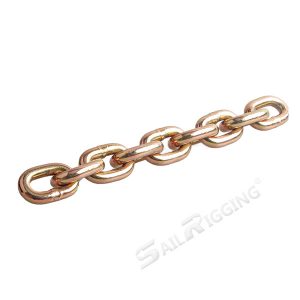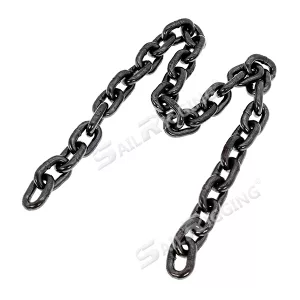What Grades Of Chain Are Used In Tie Down Chains?
Transport chains and lashings are commonly used to secure cargo on open-air flatbed trailers. One of the advantages of transport chains over lashings is that they are more durable and resistant to cutting or abrasion, which makes them a safer choice for certain types of cargo.
Table of Contents
Transport chains are particularly effective in preventing sharp edges from damaging lashings, thereby reducing the risk of cargo unhooking during transportation. Our transport chains are made of high-strength steel and are available in a variety of lengths and grades to meet different load requirements.

Transport chains are a common tool for securing cargo on open-air flatbed trailers. They are durable and wear-resistant, making them a safer choice for cargo bundling and transportation. In addition to transport chains, there is also a lifting chain in life. Here we analyze in detail the difference between 70-level transport chains and 80-level lifting chains.
What Is The Difference Between Lifting Chain And Transport Chain?
Common transport chains are G30\G43\G70\G80-level chains. Usually, 70-level chains are standard for lashing chains. Other grades of chain, 80, 100, and 120, can also be used, but are less commonly used. Below is an example of a G70 grade chain.
Grade 70 Transport Chain
G70 chains, heat-treated carbon steel chains, do not contain any alloying elements and will stretch before breaking, making them unsuitable for overhead lifting. However, they are very strong for cargo lashing and are more visible due to their gold color, so they are also called transport chains and lashing chains.
This heat-treated carbon steel chain does not contain any alloying elements. Therefore, Grade 70 chains will stretch before breaking. While this is an advantage for some applications, this chain is not designed for overhead lifting.
Instead, companies use Grade 70 transport chains to secure cargo to flatbed trucks. This means that they are only used for lashing cargo. Therefore, they are also called transport chains and lashing chains. This chain is not only very strong, but its gold color is also more visible.
G70 grade chain is commonly used in the trucking industry for cargo securing and tying down. Grade 70 transport chain is about 20 times stronger than grade 30 or 43 chain. For this reason, it is also used for hauling. Overall, tying chain has a significantly higher strength-to-weight ratio.

G80 Lifting Chain
Lifting chain is the chain attached to a crane to lift a load, also known as a chain hoist, and can be operated hydraulically, manually, or electrically. When lifting, you can use alloy chains, including grade 80 and 100. If overloaded, the chain will stretch rather than break. In any lifting operation, a broken chain can spell disaster for the safety of materials and workers.

Whether you are using grade 70 transport chain or lifting chain, be sure to choose a quality product. The higher the grade, the higher the tensile strength. For quality products for tying and lifting, please contact Qingdao Sail Rigging Co., Ltd.
Chains vs. Straps:Are straps or chains better?
Chains and straps are two common tools for securing cargo on open-air flatbed trailers. One of the advantages of chains over straps is that they are more durable and resistant to cutting or abrasion, which makes them a safer choice for certain types of cargo. Both tools are essential to the transportation process and are used to secure cargo, but each has its own advantages and disadvantages. If you want to know the specific differences between the two tools, you can read Why Choose Tie Down Chain Instead Of Tow Strap).
Why are binder chains safer choice for heavy equipment transportation? Chains can effectively prevent sharp edges from damaging straps, thereby reducing the risk of cargo unhooking during transportation. Our chains are made of high-strength steel and are available in a variety of lengths and grades to meet different load requirements. More stable and safe in long-distance transportation, especially in winter, strapping chains provide maximum strength and non-stretchable connections, are more durable, and will not wear out over time.
For example, our 1/4-inch Grade 43 Chains are rated at 2,150 pounds for light-duty load restraint applications. If you need a heavier-duty chain to secure your cargo, we also offer 1/2-inch Grade 70 Chains with Safe Working Load Limit (WLL) of 11,300 pounds.
Chains come in different grades and strengths for lashing and securing a wide range of cargo from light to heavy.Grade 43 Chains, or G43 for short, are used for light-duty securing applications such as securing utility vehicles (UTVs), all-terrain vehicles (ATVs), machinery, vehicles, farm equipment, and more. Made from heat-treated steel, Grade 43 Chains are strong and durable. They are also coated with zinc to help prevent corrosion and rust. Grade 70 Chains, or G70 for short, are used for more demanding applications such as lumber, building materials, metal coils, farm equipment, tractors, and general cargo. Grade 70 chain is also made from heat-treated steel for added strength and durability. It is also coated with zinc to help prevent corrosion and rust, which would otherwise weaken the chain over time.
Different Sizes and Strengths of Chains
Chains come in several grades, from lightweight Grade 43 (G43) to heavy-duty Grade 70 (G70). Grade 30 chain is used for light-duty securing applications, such as utility vehicles (UTVs), all-terrain vehicles (ATVs), machinery, farm equipment, and other light cargo securing applications.
Grade 70 chain is typically used for heavy-duty securing applications and comes in 1/4-inch, 5/16-inch, 3/8-inch, or 1/2-inch sizes. Grade 70 chain is used to secure lumber, construction materials, machinery, farm equipment, tractors, metal coils, and general cargo.
1/4″ Transport Chain: 2150 lbs (G43) WLL and 3,150 lbs (G70) WLL
5/16″ Transport Chain: 3200 lbs (G43) WLL and 4,700 lbs (G70) WLL
3/8″ Transport Chain: 4450 lbs (G43) WLL and 6,600 lbs (G70) WLL
1/2″ Transport Chain: 7650 lbs (G43) WLL and 11,300 lbs (G70) WLL
What grades of chain are used in tie-down chains?
Grade 70 is the standard for tie-down chains, but the specific grade and size of chain you need depends on a variety of factors. The lifting working load limit is the most important factor, and the total working load WLL of the chain used must be at least 50% greater than the total weight of the cargo.
Grade 70 lashing chain is made from carbon steel and heat treated for added strength, making it ideal for cargo transport. This chain is typically available in lengths between 16 and 25 feet and is equipped with end hardware such as cleats, cleats, or cleats with tongues.
The breaking strength and working load limit of each chain depends on the size and grade of the chain. Check the table below to see the working load limit (WLL) for each chain.
| Chain Size Inches |
Grade 30 lbs |
Grade 43 lbs |
Grade 70 lbs |
| 1/4 | 1300 | 2600 | 3150 |
| 5/16 | 1900 | 3900 | 4700 |
| 3/8 | 2650 | 5400 | 6600 |
| 7/16 | 3700 | 7200 | 8750 |
| 1/2 | 4500 | 9200 | 11300 |
| 5/8 | 6900 | 13000 | 15800 |
Grade 70 chain has a load rating approximately 20% higher than grade 43 chain, while grade 100 and grade 120 chains are 25% and 50% stronger than grade 80 chain, respectively. Higher grade chains also have better fatigue and wear resistance.
Customized Transport Chains
If you require a length or chain size not available on our website, we can provide you with a custom lashing chain to suit your application. If you would like to learn more, please feel free to contact us.
Conclusion
No matter which grade of transport chain you choose, safety and reliability are the most important. If you don’t know how to choose, you can tell Sail Rigging the load and working scene of your goods, and our product manager will provide you with a professional cargo control solution.





